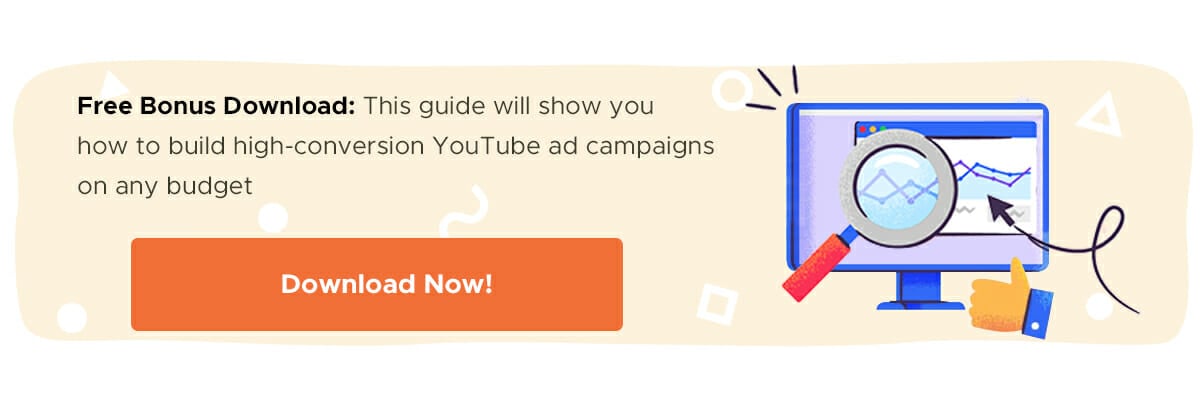If you’ve ever run a video ad campaign on Facebook, you know that you have to choose an objective. Sounds easy enough, right? You just choose one, upload your video, and it’s all systems go.
But how do you know that you’re using the correct objective? And what happens if you use the wrong one?
We thought we’d have a little fun here in the Biteable lab and see what exactly would happen if you picked the wrong objective. We ran an experiment using video ads to find out how effective Facebook is at meeting your objectives.
What we found with our test was rather astonishing, and might just save you a mountain of cash!
An Introduction to Video Objectives
Video ad campaigns are an essential tool in any marketer’s repertoire. After all, with almost 2.4 billion monthly active users on Facebook, almost every business uses this platform in some way or another. That means it pays to learn the ropes of the global giant’s vast advertising network.
Facebook lets you choose from a host of different objectives when you first set up your campaign in Facebook Ads Manager:
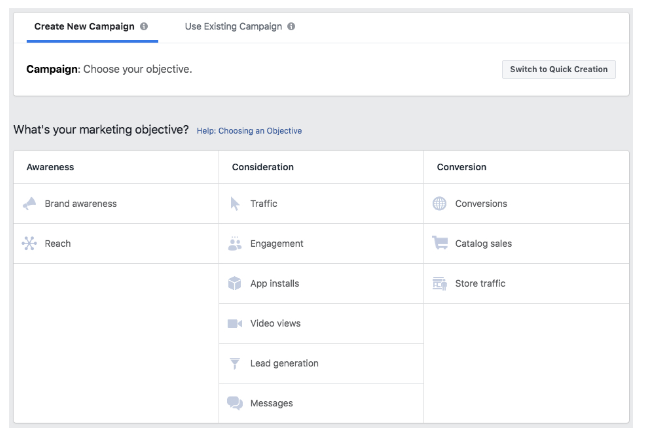
You choose the objective that matches your goal out of the following three options:
1) Awareness
This is the top stage of your marketing funnel:
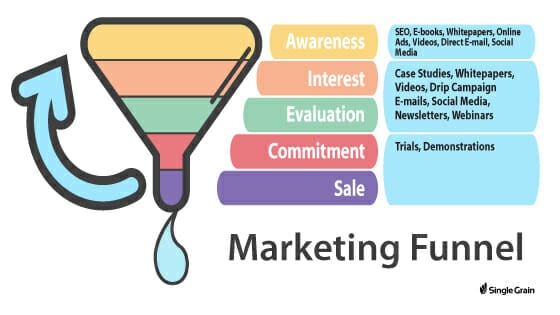
It’s used when you want to get eyeballs on your campaign and to make people familiar with your brand. If you want to get attention for your brand but are not necessarily aiming for people to engage with your content by way of leads or sales, then “Brand awareness” is the route to go.
But with a staggering 8 billion video views on Facebook every day, you need to stand out from the crowd. Think “storytelling” – i.e. introducing your brand story at the awareness stage; that should be your first step. You’re introducing the company and the product, so your video needs to pull the viewers in.
How do you do that? With vivid, emotional imagery that gets the audience to feel something. You could share a mini documentary about how you started or an emotive piece that communicates your decision point for creating the business or an example of how your product helped a customer. Your audience will be looking for inspiration in the awareness phase, and it’s your job to hook them in with a compelling narrative.
Dive Deeper: How to Create a Marketing Funnel that Generates Sales
2) Consideration
Consideration campaigns are for the middle part of your funnel and are used when you want people to engage with your brand. Clicks are your objective at this level, because you want to drive traffic to your blog or website.
If you’ve already run an awareness campaign and people are starting to know who you are, a consideration campaign is perfect for those viewers who want to go a little deeper into understanding your brand and what it offers.
Surprisingly, this is a stage that many businesses skip, to the detriment of their advertising campaign. To take your audience gradually down your marketing funnel, you’ll need to build a relationship with them so that you become a trusted expert in their eyes.
This stage takes strategy and a lot of creative thinking. You need to really understand who your audience is and show them how your product will fit into their lifestyle or solve a pain point for them. In the awareness stage, it’s time to start driving your audience away from Facebook and onto your website. Most people (up to 75%) watch videos on a mobile, so consider making your content mobile-specific as you do this.
How do you build a relationship through your video ad? Engage them with listicles that drive them to your blog content. Or build your narrative towards things you know your audience cares about. The key is to communicate your shared values so that the audience thinks ‘Hey, this brand thinks just like me.’
Dive Deeper: Turning a Lead into a Prospect with MOFU (Middle of the Funnel) Content
3) Conversion
Finally, conversion campaigns are at the bottom of the funnel. You’ve nurtured a relationship with your customers, and now you want your audience to take the final step to purchase. You need to choose leads as your objective here.
This is where your communication gets more direct. In this part of your marketing strategy, you’re chasing the sale. You’re asking them to ‘buy now’ or ‘sign up’. If you’ve already run awareness and consideration campaigns, this shouldn’t be too difficult. It’s only when marketers skip the consideration stage that they struggle to get conversions.
How do you encourage the sale without being too pushy? Well, there are different methods to employ. You can offer discounts, get influencers to endorse your brand, or provide a testimonial from someone your audience trusts. We create a lot of video campaigns so we’ve had enough experience to know that these are the most tried-and-tested objectives for each level of the funnel.
What would happen if we changed these objectives in our campaign as an experiment? Our guess is that it would not only be costly, but our results would be pretty poor. Let’s take a look.
Dive Deeper: How to Create a Facebook Video Ad that Gets Attention
Putting Our Theory to Work: The Experiment
Next, we set our plan into motion.
We started with three video campaigns and $2,600. Each campaign used the same video and the same audience, and we assigned $860 to each campaign.
By keeping the video and the audience exactly the same, we’d definitely find out how the objective would influence the results, as that was the only variable.
These were the three objectives we switched up for our video ad:
- Leads
- Traffic
- Video views
How could we make the experiment even more watertight? By going incognito, under the hood of a trusty pseudonym: ‘VideoLab.’ This was done to ensure that we removed any brand bias from the experiment.
We ran a video across all three campaigns, which took just five minutes to make, using one of our trusty templates:
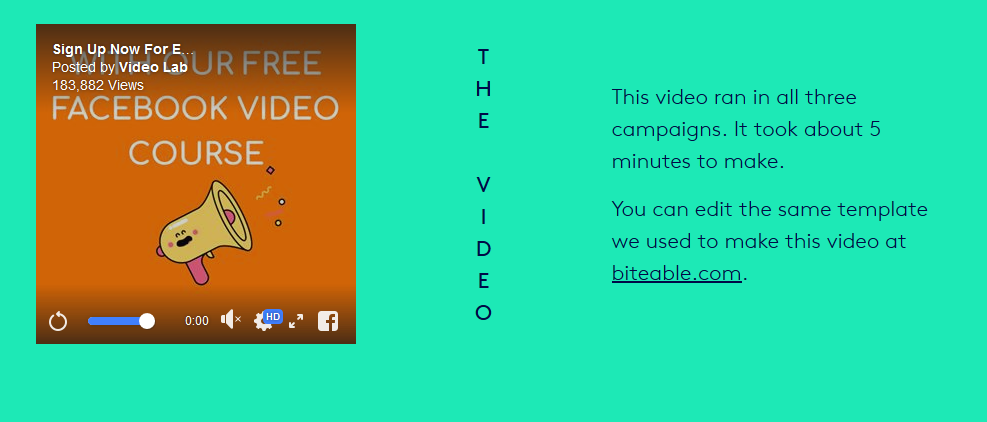
Each video ad would have a different objective so that we could see exactly how powerful each one was. We then sat back and let the ad campaigns run.
The Results
Drumroll please…! Here’s what we learned:
The “Video Views” Objective Generated Watchers
As predicted, this should do what it says on the tin. If you’re running an awareness campaign, the video views objective should be the most cost-effective route to getting maximum reach and impressions.
When we used video views as the objective, our campaign won on reach, impressions, CPM (cost per thousand impressions), average watch time, 3-second views, video watches at 50%, and video watches at 100%. That’s a lot of variables, right? The most important ones are reach, CPM, and video watches at 100%.
Here are the numbers for this objective:
- Leads got us 23,382 views on our video. Not bad. Traffic views were slightly higher, at 44, 638. But the most impressive was reach, with a nice 71,824 views.
- What about costs? Choosing the traffic objective was pricey, at $8.70 per 1,000 impressions. The leads objective cost even more, at $30 per 1k impressions. The CPM for this video view objective came in the cheapest at $7.29.
- How many people actually watched the video? Video watches at 100% were a huge 8,409 when we used the video views objective. Traffic generated a mere 2,605 watchers, and only 4,621 did so for the leads objective. That’s 311% less than the video views objective!
So in summary, video views were great for getting us noticed.
Related Content: 17 Engaging Video Content Types that People Love to Watch
The “Traffic” Objective Generated Clicks
If you can recall, we normally use the traffic objective for consideration campaigns – to attract people into the middle of our marketing funnel.
That means that in theory, this objective should get clicks at the cheapest cost. And we found this to be true:
- We found that the traffic objective got those viewers clicking: 1,516 versus a measly 626 for video views and 572 clicks for leads.
- Thankfully, it was also the cheapest option: The traffic objective cost us a tiny $0.57 per click versus $1.38 for video views and a hefty $1.52 for the leads objective. That’s a massive 166% increase for the price of CPC (cost-per-click) from selecting the ‘wrong’ objective. Yikes.
The “Lead” Objective Generated Conversions
If we want to make sales, the lead objective is the one we usually choose when we want to sign people up to a list or convert them into sales. We expect that choosing this objective would get us the most leads at the lowest price.
We were spot on:
- Choosing the lead objective generated 220 exciting leads, choosing traffic generated only 12, and video views got only 5 — a huge difference.
- It was also cheaper to bring these customers to us by choosing this objective. The leads objective was a sweet bargain at just $3.96 per lead. Choosing the traffic objective cost us a lot more per person: $72.18. Selecting video views was the most costly at $173.58 per lead — an incredible 4,283% higher. That’s a very expensive customer.
This means that objectives have a huge effect on your video ad performance.
Remember, we used exactly the same video for all three of these campaigns, with the same audience and the same budget. The objective was the only thing we changed, and the results were massively different.
We know that Facebook is incredibly good at keeping us on our toes with their algorithms. Of course, they don’t want us to know just how their elaborate data mining works. Facebook recently shared that meaningful conversations were one of the most influential factors on the platform, and that makes sense in the context of video advertising.
Social media is about relationship building, and it’s about community, so ideally you want to be targeting your video towards the people who are already talking about what you have to offer.
Multiple comments on a video, for example, shows that not only was your video popular, but it also sparked a conversation – which in Facebook’s eyes is much more valuable than mere views and likes.
Learn More:
- 8 Facebook Ad Copywriting Tricks to Maximize Conversions
- 6 Facebook Ad Hacks Crushing It in 2019
- 30 Winning Facebook Ads and Why They’re so Effective
- How to Use Live Video (Facebook & Instagram) to Grow Your Business
- 9 Tools for Creating Effective Facebook Video Ads that Convert
Your Next Facebook Video Ad Campaign
What should you do for your next video ad campaign on Facebook?
Choose Your Objective Carefully
What do you want to achieve with your shiny new video ad? Is it raising awareness of your brand, or click throughs to your landing page, or sign ups to your new program or service?
Defining your conversion goals is absolutely crucial before you set up your campaign. Remember A, C, C: Is your campaign designed to drive Awareness, Consideration or Conversion?
How well do you know your customers and how well do they know your product or service? If you’re not clear on this, Facebook won’t deliver the results you need and your video simply won’t connect with the people you’re hoping to target.
Create Video Content that Matches Your Objective
It’s important to create content that matches your objective. Once you’re clear on what that is, you can create kickass content for all your campaigns. Video templates are perfect for this as you can quickly and easily switch up brand elements to make a suite of ads.
Even though the video we used in our experiment was tailored more towards a conversion campaign, it still performed really well when paired with a different objective.
Still on the Fence about Creating Your Video Campaign?
Don’t be. With Facebook IQ discovering that people associate mobile video with positive emotions and were 1.8 times likely to be inspired by mobile video than TV, it’s clear that investing in video advertising will be money well spent:
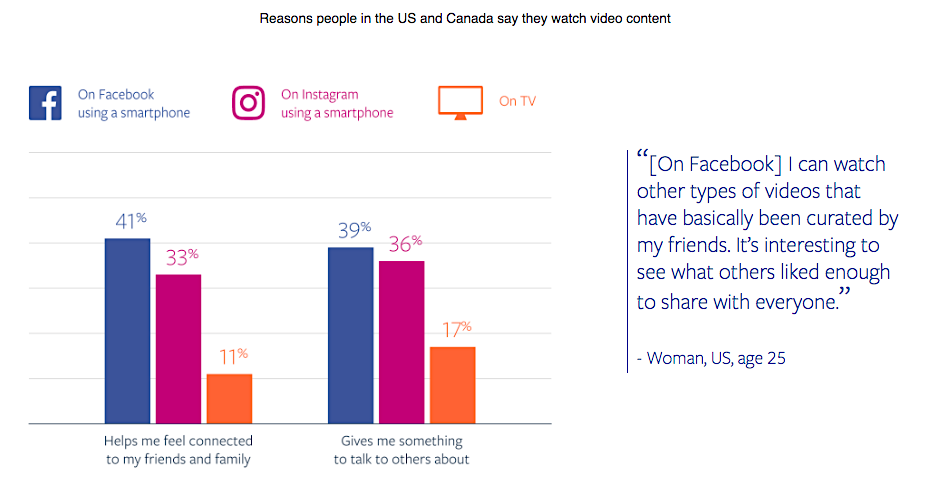
When creating your next Facebook video ad, keep these points in mind:
- Facebook’s algorithm is genius: It’s super efficient at finding the right kind of people within an audience, and it will always prioritize video content.
- The right objective matters: Careful consideration in the planning stages will help you be effective in crafting the message that will impact the customer most along their journey.
- Wrong objectives are expensive: A poorly chosen objective will cost you big-time: up to 4,238% more.


